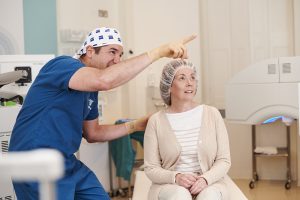Can Cataract Surgery Correct a “Lazy Eye”?

The primary aim of Cataract Surgery is to remove cataracts from the eye and address cataract-related vision loss. But that doesn’t necessarily mean that the procedure can’t help with other problems. For example, private Cataract Surgery can address refractive errors in addition to vision impairment caused by the cataract itself. So, what about other types of eye-related issues?
In this article, we’re taking a look at “lazy eye” (also known as amblyopia) and whether Cataract Surgery could help to correct the condition.
What is “Lazy Eye”?
Amblyopia is a vision development disorder in which one eye has poor visual acuity. Over time, the brain begins to rely increasingly on the images sent by the ‘stronger’ eye and vision in the weaker eye worsens.
Amblyopia is relatively common with an estimated prevalence of 2-5% in the UK. It starts in childhood and represents the most common cause of vision loss in children.
The disorder occurs despite no apparent eye injury or disease, however, it is most commonly caused by misalignment of the eyes, known as strabismus. Other underlying causes include refractive error (such as short-sightedness, long-sightedness, and astigmatism) and early-onset cataracts.
If amblyopia is caused by a refractive error in the affected eye, visual aids such as glasses or contact lenses may help to manage the disorder. However, it is often necessary to “re-train the brain” to use the weaker eye as well as the stronger one. This can be achieved by using an eye patch or administering eye drops to the stronger eye.
Early initiation of treatment for amblyopia is highly recommended. Treatment in children tends to be more effective in children than in adults with delayed treatment potentially leading to lifelong vision problems.
Cataracts and Amblyopia (Lazy Eye)
While the vast majority of cataract cases occur in older individuals, children can also be affected by cataracts either from birth (congenital cataract) or later (developmental/infantile cataract). In cases where amblyopia is caused by cataracts, this needs to be addressed before other treatments can be initiated.
Surgery is the only effective treatment of cataracts. It involves removing the cataract-affected lens and replacing it with an artificial intraocular lens (IOL). In patients whose amblyopia is caused by cataracts, Cataract Surgery can be effective in fully correcting, or at least significantly improving the associated visual impairment.
However, the likelihood of Cataract Surgery fully restoring vision is less likely in adults than in children. Depending on the severity of amblyopia and whether or not “lazy eye” is caused by the cataract, results can vary. Still, it is possible that there may be some noticeable improvement in visual acuity following Cataract Surgery.
Will I still need glasses for amblyopia?
As mentioned earlier, glasses and other visual aids can be extremely useful in managing symptoms of a lazy eye. But will these still be needed after Cataract Surgery?
Well, once again, the answer will be dependent on the exact circumstances of the amblyopia. In childhood amblyopia that is caused by congenital or developmental cataracts, removal of the cataract may be sufficient to correct the problem.
In some cases, intraocular lenses may provide sufficient corrective power to manage amblyopia caused by refractive error; however, this too may be much less likely to be the case in adults.
Cataract Surgery in patients with a lazy eye is generally safe and effective. However, the extent to which the procedure can improve the condition can vary greatly from patient to patient. Following your initial screening and consultation, your surgeon will be able to tell you more about your personal treatment and what you can expect after surgery.
For more information about Cataract Surgery at London Vision Clinic, get in touch with one of our friendly clinic coordinators. Alternatively, Book a Consultation today.


